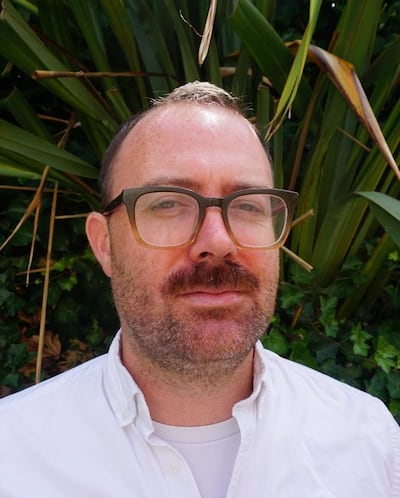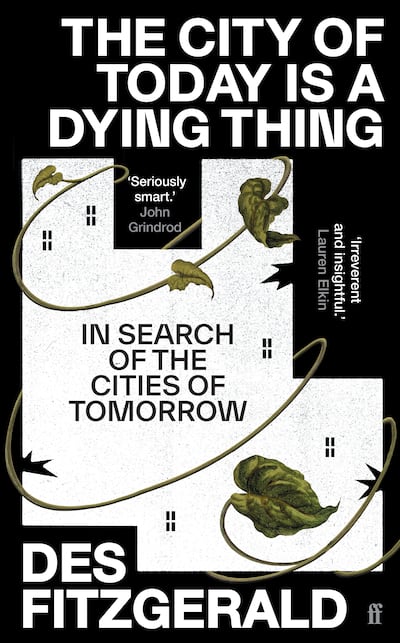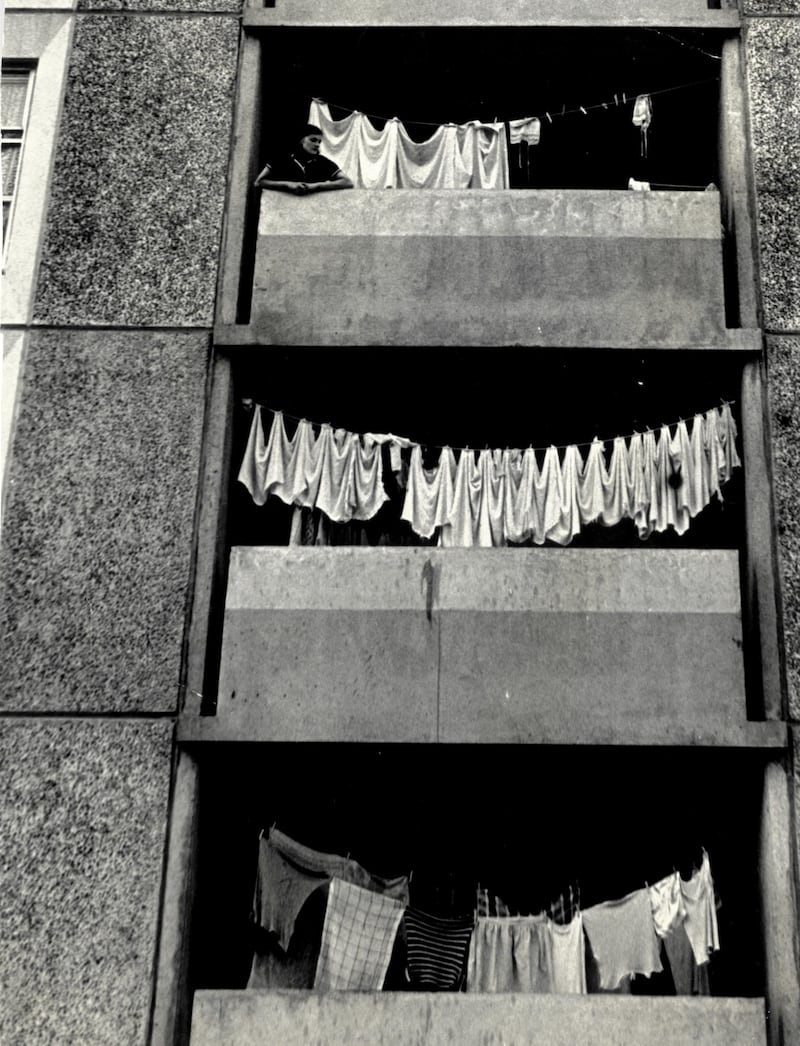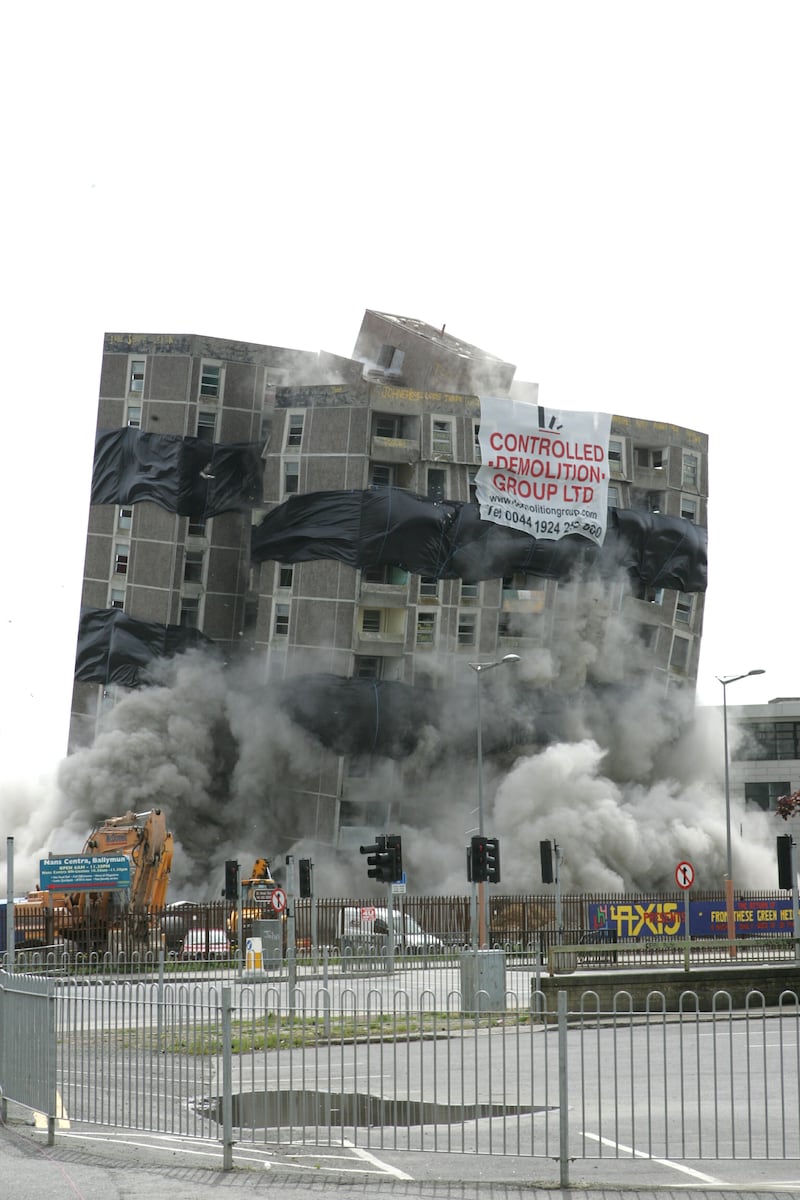In the final week of January, a flyer asking people to move their cars from Furlong Street and the Marina Walk, on the south docklands of Cork city centre, signalled the start of an urban transformation that had been anticipated for some time: demolition of the R&H Hall building, a pair of enormous interlocked, concrete grain silos, would start by the end of the month.
The R&H Hall building is something like a Cork equivalent of London’s Battersea Power Station – an enormous, uncompromising industrial structure built incongruously in an urban centre, now being gradually marooned by a rising tide of gentrification and municipal ambition. Still, the sheer scale and hulk of the building, as well as its dominant dockland position, have made it a sometimes-unwelcome visual signifier for the city more generally.
As a child, I would look for it keenly from the back of my parents’ car. Arriving home from a my grandparents’ house up the country, there was a moment, just beyond the crumbling Victoriana of the Lower Glanmire Road, when the car would swerve dramatically on to Horgan’s Quay – and there was the enormity of R&H Hall on the far side, not welcoming you home exactly, but at least projecting a kind of warm solidity and predictability that belied its utilitarian, now rather derelict, state.
As the news spread, reaction to its imminent demolition wavered between good riddance to a brutalist eyesore, and half-reluctant lamentation for another remnant of Cork’s industrial past – one of a diminishing set of signifiers of the city’s long-cherished status as a place that would be distinctive, even where it couldn’t be beautiful.
We need secular schools, but also schools that believe in what the nativity play embodies
Ireland has a choice on migration: Follow the UK into the vortex or hold on to its values
Artists and musicians are constantly hustling. They need more State support
Chief Rabbi: Move to erase Chaim Herzog’s name and history is cruel hammer blow
Something important is changing – but not only at the level of the skyline. In a 2008 master plan for the Cork south docks, architects and designers conjured visions of a surprisingly green and leafy space, something like a garden suburb, held together by interconnected “pocket parks” and a tree-lined riverside promenade. “New buildings,” said consultants, should be “constructed to the most stringent environmental standards, incorporating natural and recyclable materials, green roofs [and] stormwater run-off.”
The city docks will eventually become ‘the largest regeneration project in Ireland’, says the Port of Cork Masterplan, as industry moves further and further out of the centre
Images of the development that will now replace the demolished R&H Hall show attractive new apartment blocks, retail spaces and a new private hospital, all with green roofs, and surrounded by trees. There are reports that the next phase of development, on the site of an old fertiliser factory, will feature “green space and a plush new village square”.
In overhead images, you get a truly expansive sense of this urban vision, as the new “city within a city” blends into the vast green expanse of the new 32-hectare Marina Park, past Supervalu Pairc Uí Caoimh, and on into Lough Mahon. The city docks will eventually become “the largest regeneration project in Ireland”, says the Port of Cork Masterplan, as industry moves further and further out of the centre. The area will become a “green lung for the city” with “green and blue infrastructure designed using nature-based solutions”.

This desire to do away with the uncompromising, industrial, concrete city of the 20th century, and embrace instead a green, nature-oriented future is widespread in visions of the future Irish city. In 2022, for example, Limerick was named a “European Green Leaf City”, promising to become a “beacon of nature walks” with “wildflowers on the roundabouts”. In 2023, Dublin became a “Global Green City” during a forum at the Cop28 conference (in the unfortunately not very green city of Dubai). Galway maintains a quixotic campaign to have itself identified as a “National Park City”, an international movement aiming to remake cities as places “rich with nature... where we all enjoy high quality public and green spaces [and] the air is clean to breathe”.

Waterford – “Ireland’s most liveable place” – claims to be at “the centre of a green transformation connecting the city to its region by a network of three major greenways... a ‘walkable’ city at the heart of a sustainable network.” Ballina, not to be left behind, insists that it is soon to become “Ireland’ greenest town”, with initiatives including space for nature under a roofed town centre, a set of “eco-corridor greenways”, and a plan to grow vegetables for local restaurants on the sides of car parks.
A recent report by Hassell Studio, an international architecture and urban planning firm, suggested that one of the main arguments for “15-minute cities” in Ireland is that more compact living increases contact with nature, and gives everyone better access to green and blue space. Trees, meanwhile, will be reimagined as infrastructure, which is good for our mental health.
Urban planning, agrees the Royal Institute of the Architects of Ireland, has a direct effect on “people’s health, wellbeing and happiness”. We need to design “places where people feel connected to nature”, they argue in their towns toolkit, with “clean air and sunshine” and “access to natural landscape features”.
The Swiss-French architect and planner Le Corbusier wrote that we should think of the city as ‘the grip of man upon nature’ – even as a ‘human operation directed against nature’
Something transformational is under way here. The Dublin or Limerick of the future will not be grey, or windowless, or made from concrete. It will not be industrial, or overbearing, or loud. Rather it will be modest in scale and sustainable. It will be made from natural materials and surrounded by clean air. It will be covered with trees and flowers. Its physical structures will be gentle and rounded, perhaps even referencing the soft, thatched forms of the traditional vernacular – the physical form, after all, in which a long-standing imagination of pre-industrial and premodern Ireland has been grounded.
At the economic and intellectual high point of the modern city, when steel and concrete structures cut their way unabashedly through European streets, the Swiss-French architect and planner Le Corbusier wrote that we should think of the city as “the grip of man upon nature” – even as a “human operation directed against nature”. Today, that relationship has been reversed. It is nature, now, that has urban space in its soft and leafy hold, squeezing, shaping and – as R&H Hall is about to find out – demolishing as it sees fit.
[ The sad truth is that we do not have urban planning anywhere in IrelandOpens in new window ]
Certainly, there are structural and market factors behind this rising tide. These include legislative nudges to transform ex-industrial brownfield sites into attractive housing, a growing awareness of the role of urban development in meeting ever-receding climate targets, and an incentive for private developers to project images of the kinds of places – human-scale, walkable, tree-laden – that people consistently say they want to live. But something else is going on too – something that is in one sense very new, and in another sense, not new at all.

The new bit has to do with urban mental health. We have known for some time that mental health problems are over-represented among urban dwellers. Recently, however, researchers have become convinced that what explains this connection is a lack of contact with nature in the city. The experience of urban living is hard, overbearing and stressful. It separates us from the kinds of environments – open, leafy, riverine – within which we evolved, and which our tired brains still crave. In one Danish study, scientists showed that the volume of greenery near your home as a child predicted your likelihood of developing a mental health condition in adulthood. At UCC, researchers used a data set of online images of Dublin, Cork and Galway, and matched it with census data to show that the more green space a person experiences at street level, the better they rate their own health. Rapid urbanisation, these researchers pointed out, is a major public health challenge. As one architect put it to me: “When you build modern architecture... you’re building stressful architecture.”
This all seems fair enough. And yet there is also something here that smacks of the 19th century – a period when we may not have had a language of stress or mental health to condemn the city, but we did have the language of moral purity. Because the hope that nature will cure the ill effects of the modern city is not new at all. “We must restore the people to the land,” wrote Ebenezer Howard, the founder of the international Garden City movement 1898: only through regular contact with nature can the urban problems of intemperance, anxiety, and overwork be resolved. In 1833, a British parliamentary commission argued that forcing “the humbler classes” to spend time in parks would keep them from the “low and debasing pleasures” of drinking, dogfighting and boxing.
The subsequent boom in park building gave us both the landscaping of the then derelict Phoenix Park in Dublin, and the creation of Fitzgerald’s Park in Cork. In 1865, the American landscape architect and designer of Central Park, Frederick Law Olmsted, wrote that without the ability to contemplate natural scenes, urban dwellers would become morose and irascible, dull and immoral. As the historian Clare Hickman points out, the history of urban green space across these islands involves both a medical anxiety about keeping the industrial worker fit and ready for labour, as well as a moral concern about preserving their good character from low pursuits – both were unacceptable risks for the steady and sober progress of Victorian industry. What if this Victorian moralising and anxiety about work discipline hasn’t gone away, but has simply come back again, now in the language of stress, sustainability and mental health?
We have been here before. When an impressed Irish Times visited the ‘soaring new town’ of Ballymun in 1968, it encountered ‘a place of thrusting, vigorous children, and of young, energetic parents’
It seems perverse, in the middle of a housing crisis, to object to new, walkable, nicely landscaped development. It is maybe more perverse, amid climate and mental health crises, to worry about municipal visions of a green, sustainable urban Ireland. Yet there is something conservative and backward-looking in these new visions. They continue a line of thinking about urban life, and of modern life more generally, from reactionary philosophers such as Roger Scruton, who thought the modern city an enemy of “communal order”, to the well-known ruralist fantasia of Éamon de Valera, centred on the moral and material frugality of the honest field labourer (who, no doubt, enjoyed excellent mental health).


It must be possible, surely, to imagine an Irish urban future without a psychological or medical recasting of these ideas – a vision that sees concrete and industry, and their attendant noise and ugliness, that sees a building like R&H Hall not as a public health crisis, but takes it rather as a sign of the energy, conviviality, diversity, surprise, and, yes, risk, that humans have long sought in urban spaces.
We have been here before. When an impressed Irish Times visited the “soaring new town” of Ballymun in 1968, it encountered “a place of thrusting, vigorous children, and of young, energetic parents”. The highest towers had then just been constructed using the “Balency et Schuhl” construction system, connecting Ballymun to many of the most innovative and forward-looking urban housing developments in Europe, including London’s iconic Thamesmead, the self-conscious “town of tomorrow”, very much still standing today.
We don’t have to ignore how this development didn’t work to connect it to other 20th century ideas and remember that other urban futures were once possible. These would include the Dublin new town vision of Myles Wright in 1967. They would include the work of Eamon O’Byrne, Cork city architect in the 1950s and 1960s, who delivered a wave public housing schemes, that were, says the geographer Denis Linehan, “progressive, typically European and modern”, and remember that other visions of Ireland’s urban future were and are possible.
They would include too what architectural scholars Gary A Boyd and John McLaughlin call the “dispersed and decentralised modernism” of places such as Shannon, Birr, and Athlone. Amid the housing and climate crisis, the apologetically green and modest visions of our own era add a crisis of imagination and ambition – the ideological retreat, indeed, of a once-confident state willing to advance its own vision of the urban future, and to build that vision, in marked contrast to the often insipid, cautious market-driven approach of 21st century urban Ireland.
Des Fitzgerald is professor of medical humanities and social sciences at UCC. The City of Today is a Dying Thing is published by Faber & Faber
- Sign up for push alerts and have the best news, analysis and comment delivered directly to your phone
- Find The Irish Times on WhatsApp and stay up to date
- Our In The News podcast is now published daily – Find the latest episode here












